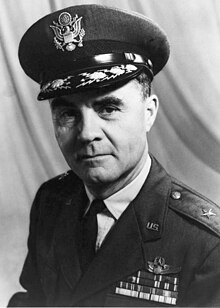Paul Tibbetts
| Paul Tibbets | |
|---|---|

Brigadier General Paul W. Tibbets Jr.
|
|
| Birth name | Paul Warfield Tibbets Jr. |
| Born |
23 February 1915 Quincy, Illinois, United States |
| Died | 1 November 2007 (aged 92) Columbus, Ohio, United States |
| Allegiance |
|
| Service/branch |
|
| Years of service | 1937–1966 |
| Rank | Brigadier General |
| Commands held |
340th Bombardment Squadron 509th Composite Group 308th Bombardment Wing 6th Air Division |
| Battles/wars |
World War II: |
| Awards |
Distinguished Service Cross Legion of Merit Distinguished Flying Cross (2) Purple Heart Air Medal (4) |
| Other work | Charter Pilot and President of Executive Jet Aviation |
World War II:
Paul Warfield Tibbets Jr. (23 February 1915 – 1 November 2007) was a brigadier general in the United States Air Force. He is best known as the pilot who flew the Enola Gay (named after his mother) when it dropped Little Boy, the first of two atomic bombs used in warfare, on the Japanese city of Hiroshima.
Tibbets enlisted in the United States Army in 1937 and qualified as a pilot in 1938. After the Japanese attack on Pearl Harbor, he flew anti-submarine patrols over the Atlantic. In February 1942, he became the commanding officer of the 340th Bombardment Squadron of the 97th Bombardment Group, which was equipped with the Boeing B-17. In July 1942 the 97th became the first heavy bombardment group to be deployed as part of the Eighth Air Force, and Tibbets became deputy group commander. He flew the lead plane in the first American daylight heavy bomber mission against Occupied Europe on 17 August 1942, and the first American raid of more than 100 bombers in Europe on 9 October 1942. Tibbets was chosen to fly Major General Mark W. Clark and Lieutenant General Dwight D. Eisenhower to Gibraltar. After flying 43 combat missions, he became the assistant for bomber operations on the staff of the Twelfth Air Force.
Tibbets returned to the United States in February 1943 to help with the development of the Boeing B-29 Superfortress. In September 1944, he was appointed the commander of the 509th Composite Group, which would conduct the bombings of Hiroshima and Nagasaki. After the war, he participated in the Operation Crossroads nuclear weapon tests at Bikini Atoll in mid-1946, and was involved in the development of the Boeing B-47 Stratojet in the early 1950s. He commanded the 308th Bombardment Wing and 6th Air Division in the late 1950s, and was military attaché in India from 1964 to 1966. After leaving the Air Force in 1966, he worked for Executive Jet Aviation, serving on the founding board and as its president from 1976 until his retirement in 1987.
...
Wikipedia
